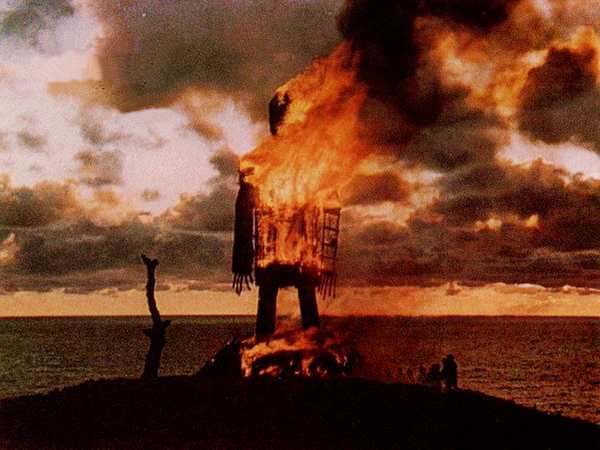The sight of a towering Wicker Man set ablaze is more than a striking spectacle; it’s a deep-seated ritual that transcends centuries. Rooted in ancient practices, the Wicker Man symbolizes various cultural and religious traditions involving sacrifice and renewal. This powerful imagery endures through both historical accounts and contemporary interpretations, reflecting its enduring impact on our collective consciousness.
The Historical Origins of the Wicker Man
The Wicker Man’s origins trace back to ancient Celtic practices, where it was purportedly used in ritualistic ceremonies. According to Julius Caesar’s Commentarii de Bello Gallico (Commentary on the Gallic Wars), the Wicker Man was a large wicker effigy used by the Druids, the priestly class of Celtic paganism. Caesar’s accounts describe these massive structures being used for human sacrifices, where individuals were burned alive inside the effigy. Despite skepticism from modern historians about the accuracy of Caesar’s accounts, the concept of the Wicker Man persists in historical records and contemporary rituals.
Modern-Day Rituals and Celebrations
The ritual of burning the Wicker Man continues to be practiced, though often in a modified form. This tradition has survived into modern neo-pagan rituals and cultural events, such as the famous Burning Man festival in Nevada, where a similar symbolic act of burning an effigy represents personal and communal transformation.
A recent celebration highlights the persistence of this ancient practice. On January 30, 2009, a 12-foot tall Wicker Man was set ablaze near the Fermanagh border in Northern Ireland. This event was part of a pagan winter ritual celebrating the end of winter and the approaching spring, marking February 1, known as a Quarter Day in the Celtic agricultural calendar. The ritual took place at the Aughakillymaude Mummers Centre, where straw mummers’ hats were also burned to signify the end of the mumming season.
Gordon Johnston crafted the Wicker Man from flexible sally rods, a traditional material used in wickerwork. Jim Ledwith of the Mummers Foundation explained that while the specifics of ancient Wicker Man rituals are not fully understood, the practice of burning effigies has historical roots in Celtic traditions. Although human sacrifices were part of ancient practices, contemporary ceremonies focus on symbolic acts rather than actual sacrifice.
Symbolism and Cultural Echoes
The Wicker Man has left a significant mark on popular culture, especially in horror cinema. The 1973 film The Wicker Man, starring Edward Woodward and Christopher Lee, is regarded as a classic of the genre. The film’s climax, where Woodward’s character is burned alive inside the Wicker Man, reflects the deep symbolism and horror associated with these rituals. The movie’s influence extends beyond horror, with references and homages appearing in various other works.
One notable example is the 1973 Anglo-Italian thriller Don’t Look Now, directed by Nicolas Roeg. The film features a mysterious figure in a red raincoat, which serves as a symbolic link to the themes of premonition and tragedy. This motif of the red-clad figure recurs in various films and television shows, such as the American remake of The Wicker Man (2006) starring Nicolas Cage, and other cultural references including the TV series Absolutely Fabulous and the film Intermission.
The red-clad figure, reminiscent of the one in Don’t Look Now, also appears in other media, from the film The Dark to the thriller Hostel. This recurring theme underscores the pervasive influence of the Wicker Man’s imagery on contemporary storytelling.
Understanding the Ritual’s Significance
The Wicker Man’s ritualistic burning symbolizes the cyclical nature of life and the renewal of seasons. Historically, such practices were intended to ensure fertility, successful crops, and the overall well-being of the community. In modern contexts, these rituals have evolved into symbolic acts celebrating personal and communal transformation, often without the darker aspects of ancient practices.
For those intrigued by the Wicker Man and its symbolism, it’s essential to approach the topic with an understanding of both its historical roots and its modern interpretations. The ritual’s enduring presence in cultural and cinematic narratives highlights its powerful impact on our collective imagination.
The Wicker Man in Popular Culture
The Wicker Man’s influence extends beyond historical and ritualistic contexts into popular culture. The 1973 film The Wicker Man remains a seminal work in horror cinema, and its legacy continues to inspire various adaptations and references. The motif of the red figure, as seen in other films and TV shows, illustrates the Wicker Man’s lasting impact on storytelling and cultural symbolism.
In conclusion, the Wicker Man represents a fusion of ancient rituals and modern interpretations. Its role as a symbol of sacrifice, renewal, and transformation persists through various cultural expressions, from historical accounts and neo-pagan rituals to influential films and media. Understanding the Wicker Man’s significance offers valuable insights into how ancient practices continue to resonate in contemporary culture.

